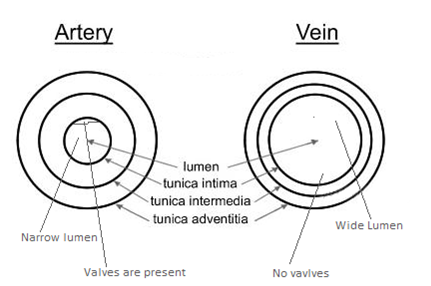Sponsor Area
The Circulatory System
The diagram given below represents the human heart in one phase of its functional activities. Study the same and answer the questions which follow:
(i) Name the phase.
(ii) Label the parts 1, 2 and 3.
(iii) Which part of the heart is contracting in this phase? Give a reason to support your answer.
(iv)Draw a well-labeled diagram of part 1 and 2 to show the structural differences between them.
(i) Atrial systole
(ii) The parts are :
1-Pulmonary artery
2- Superior vena cava
3-Aorta
(iii) Atria are contracting in this phase. In the diagram, arrows indicating the flow of blood are shown from atria to ventricles.
During the atrial systole, the atria contract and the blood moves from the atria to the respective ventricles.
(iv) Pulmonary Artery is an artery while Superior vena cava is a vein 
Some More Questions From The Circulatory System Chapter
State the exact location of the following:
Pulmonary semilunar valve
Choose the correct answer from the four options given below:
Pulse wave is mainly caused by the
Differentiate between the following pairs on the basis of what is mentioned within brackets:
Bicuspid valve and Tricuspid valve (function)
The diagram given below represents the human heart in one phase of its functional activities. Study the same and answer the questions which follow:

(i) Name the phase.
(ii) Label the parts 1, 2 and 3.
(iii) Which part of the heart is contracting in this phase? Give a reason to support your answer.
(iv)Draw a well-labeled diagram of part 1 and 2 to show the structural differences between them.

(ii) Label the parts 1, 2 and 3.
(iii) Which part of the heart is contracting in this phase? Give a reason to support your answer.
(iv)Draw a well-labeled diagram of part 1 and 2 to show the structural differences between them.
Name the following:
iii. The vein that carries oxygenated blood.
iii. The vein that carries oxygenated blood.
Rewrite and complete the following sentences by inserting the correct word
in the space indicated:
Oxygen combines with haemoglobin present in RBC and forms ___________.
in the space indicated:
Give the biological/technical terms for the following:
ix. The sound produced when the atrio-ventricular valves close in the heart.
ix. The sound produced when the atrio-ventricular valves close in the heart.
The diagrams given below are cross sections of blood vessels:

i. Identify the blood vessels A, B and C.
ii. Name the parts labelled 1 to 3.
iii. Name the type of blood that flows through A.
iv. Mention one structural difference between A and B.
v. In which of the above vessels does exchange of gases actually take place?

i. Identify the blood vessels A, B and C.
ii. Name the parts labelled 1 to 3.
iii. Name the type of blood that flows through A.
iv. Mention one structural difference between A and B.
v. In which of the above vessels does exchange of gases actually take place?
Differentiate between the following pairs on the basis of what is mentioned
within brackets:
ii. RBC and WBC (Shape)
within brackets:
ii. RBC and WBC (Shape)
The diagram below represents the human heart in one phase of its function.
Study the diagram carefully and answer the questions that follow:
i. Name the phase.
ii. Which part of the heart is contracting in this phase? Give a reason to support your answer.
iii. Name the parts labelled 1 to 4.
iv. What type of blood flows through ‘2’?
v State the function of the part numbered ‘5’.
vi Name the membrane that covers the heart.
Sponsor Area
Mock Test Series
Mock Test Series





